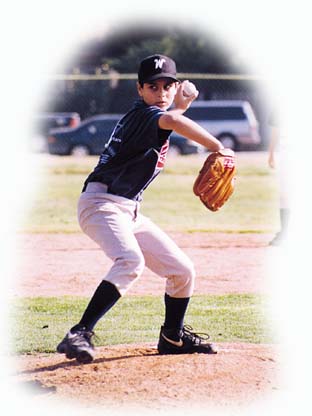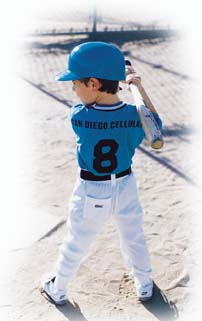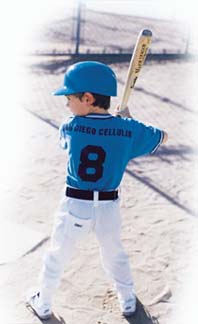News and Announcements
The 2003 RGMVM Major Division Power Hurler !
Posted by Patrick Piteo at Nov 30, 2003 4:00PM PST
( 0 Comments
)
"TJ" Fox Is The RGMVM Power Hurler Of The Year In The Major Division. TJ has played for RGMVM since 1997, when he won the MVP in the Instructional All-star game. TJ was on the mound in 1998 and struck out the final batter to win the 1998 Rookie World Series. This year, his last year in the Major Division, TJ dominated on the pitchers mound, pitching 36 innings, allowing only 15 hits and 7 runs, while striking out an amazing 82 batters!! His strong pitching continued in the 2003 all-star game, where he worked 2 scoreless innings and struck out 6, earning the MVP award for a second time (his younger brother Matthew was awarded the MVP for the 2003 Rookie game, the first time brothers have won the award on the same day). TJ pitched on the RGMVM Little League Tournament teams in 2001 & 2003. In 2001, he allowed only 3 run's in 7 innings pitched; in 2003, although he pitched 4 shutout innings and got the win against Briarwood, his personal highlight came when he pitched 6 innings, allowing 2 runs and striking out 12 against Ozone Howard, in a game the team eventually lost in extra innings. TJ's dominance on the mound continued during the Diamond Pro's Fall League, where he competed against the premier players from other areas. Representing RGMVM, TJ's playoff performance against Bronxchester and Williston Park was excellent. He pitched 20 innings, allowing 7 hits, 2 runs, and striking out 41!! Although RGMVM came up one game short of the championship, TJ's performance against previously undefeated (36-0) Williston Park earned him rave reviews. He pitched 6 innings, striking out 15, allowing 1 unearned run, and handed Williston their only loss in two years. TJ never lets his pitching talent go to his head. He is always there for his teammates and never puts himself above the team. He is truly a great competitor and always shows good sportsmanship. Enough Said! That is why TJ FOX is 2003 Power Pitcher of the Year in the Major Division…………….
Schawaroch Chapels Major Softball Championship Celebration!
Posted by Patrick Piteo at Oct 26, 2003 4:00PM PST
( 0 Comments
)
On a beautiful Sunday afternoon Schawaroch Chapels, the RGMVM Little League, Major Softball Division World Series Champions met to celebrate their victory. They started the day with an exciting parent-daughter game of softball. Their sponsor Stephen Schawaroch was there to cheer on his team. The girls took home the win 5-4, making Stephen proud. The parents took home some aches and pains and bruised egos swearing to win next season. After the game, team manager Mark Ferran distributed victory plaques to the girls and to Stephen. Beautiful team jackets were also given to each girl. These jackets were a special gift donated to the team by Stephen Shawaroch. We would like to thank him for his generous gift and for his continued support to the RGMVM Little League. Stephen is a fine example to the local community of how small businesses can support the children of our neighborhoods. We would also like to thank Anthony Ululati of Needle Heads for his gift of really cool shirts for each team player. We really appreciate it. After, many pictures were taken with Stephen and the girls with their team jackets, followed by a pizza party at Leone’s. Fun was had by all that attended this victory celebration.
by Don Marsh One of the very first things I tried to teach our son, Zachary, who’s now a starting pitcher for his high school team as a sophomore, was that even a Hall-of-Famer isn’t going to always have his best stuff. I told him that, on the average, one of every four times he walks out there he’s going to have to try to survive on his wits, because for whatever reason, the skills just won’t be there. Proof lies in his recent winter baseball experience, which lasted a total of four games. During the first three outings he struck out fourteen kids in a total of six innings of work. He was feeling pretty good about himself, as he took the mound for the fourth start. Then the wheels fell off the cart. Afterward, I sat him down in the bleachers and tried to walk through some individual pitch selections he had made, but mostly to remind him of the story he’d been told all those many seasons ago. He listened. And eventually felt better about his future, if not his current performance. What do you do when the fastball’s not moving, the curveball’s flat and the change-up takes about four bounces on the way to home plate? The answer, in a word, is “Simplify”. Unless there is an injury involved, problems for a pitcher almost always are a matter of good mechanics temporarily gone bad. Keep in mind that, as we’ve said before, there are four parts to the pitching motion, and even a small breakdown in any one of them, leads to problems the rest of the way through. If, for example, you’re having problems with your balance following the step-back, the first part of the motion, then start pitching from the stretch. This gives you a better chance of reaching your balance point, which is the second part of the motion. If you’re having problems with your control, make sure your plant foot is facing home plate on the landing and that it’s landing in the same place, every time. That’s the third part of the pitching motion. Then make sure your follow-through is “throwing-hand-to-opposite-knee”. That’s the fourth part. Most of all, just slow down. Take your time. Don’t try to throw every pitch perfectly. Just try to throw one strike at a time, and let your teammates do the rest of the work for you. Simplify. And then go out and get them with your best stuff the next three times.

By Don Marsh You already have learned some basic lessons on hitting, such as how to choose the right bat and how to properly set up in the batter's box. In this lesson, I will help you to correct hitting mistakes that a lot of kids make. Look at the player in the two photos on this page. If you think about what you have learned so far, you can tell that the boy is correctly set up in the batter's box. He also has a bat that is the right size for him. But look closely. In one picture, he is holding the bat almost straight up. In the other picture, the bat is almost flat and sitting on his shoulder. When the pitch comes, which one of those bat positions will help the boy to hit the ball far? If you picked the picture where the boy is holding his bat pointing upward, you're right. In that position, the boy will have a faster swing and he will be able to pull the ball to left field. The way you hold your bat - straight up, slightly tipped, or flat - creates an "angle". Making the correct angle with your bat is an important part of "bat speed". To be a good hitter, you must have bat speed! If you hold your bat flat or down, you will have a slower swing. The wrong angle makes it hard for you to create a fast bat speed. Here is a great way to find out for yourself about bat speed: Set yourself up in your batting stance and hold the bat flat, like the boy in the picture to the right. Take one hand off the bat. Close your eyes and think about how heavy the bat feels. Keep your eyes closed, and have a parent or coach raise the angle of the bat until it is straight up (see boy on left). Does the bat feel heavier, the same, or lighter than it did before? I'm pretty sure you will say "lighter". This means you will be able to swing the bat more quickly, and you will have a faster bat speed. Remember this lesson when you are playing baseball, and you will soon become a better hitter!



By Jim Morris, Head Coach University of Miami The most important zone to learn to hit is the outside zone. Three quarters of pitches that a hitter sees are on the outside part of the plate or off the plate away. Most breaking balls and change ups are away from the hitter. Every hitter should concentrate on the outside pitch! The contact point for the hitter on an outside pitch is much closer to the catcher, or deeper over the plate, than the other pitches. Contact for the low-and-away pitch is opposite the back knee. The middle-away pitch is contacted opposite the mid-line of our body. The up-and-away zone is met even with our front shoulder. The lower the pitch, the deeper you let it get. The more the pitch is away, the deeper you let it get; more so than based on the pitch’s height. If the hitter gets too far out front, the angle of the bat causes the outside pitch to be pulled. Unless the hitter is very strong physically, he ends up pulling many weak ground balls and fly balls to the left side. Hitting the outside pitch out front means the hitter has expended most of his power by the time contact is made. Hitting the ball deeper in the zone enables the hitter to drive the ball toward the opposite field. The bat is angled toward the opposite field when contact is made at the proper point. When contact is made the hands are ahead of the barrel. The low-and-away pitch has the bat angle of approximately a 45-degree angle to the ground. The middle-away pitch has the bat horizontal to the ground. The up and away zone is contacted with the barrel about 15 degrees above the hands. Most hitters stride at about the point of release from the pitcher. They do this because they have no idea what type or speed the pitch is at that point. When the hitter strides, the weight is transferred to the back foot. To compensate for slower pitches (curve ball, change up) there is a pause or separation between the stride and swing. Otherwise, the hitter has completed his swing and here comes the change up! There is a longer pause or separation on pitches that are outside or low, because they are hit deeper in the zone and have to travel farther. To keep from pulling off the outside pitch, the hitter has to stay closed in the front side. When the front hip, shoulder, and then the head pulls off the ball, chances of hitting it solidly are remote. The hitter either pulls the outside pitch, hits it off the end, or swings and misses. A good coaching point when teaching hitters is to get them to stride toward the opposite middle infielder with a closed front toe. The right-handed hitter strides toward the second baseman. If the hitter strides with an open front toe, toward the pitcher, or in the bucket, the front side of the body opens up too early. This toe-to-instep stride not only helps on pitches away, but also keeps the head on the ball longer. The low pitch and outside pitch are the leastwatched zones because they are farther from the eyes. The back hip is the important hip when hitting the outside pitch. The front hip stays closed. Then the hitter really pops the back hip into the outside pitch. Driving the back hip into the ball provides the power to drive the ball hard to the opposite field. Every swing starts inside out. This means the arms do not extend too early behind the hitter. Getting outside or around the ball makes the hitter pull the outside pitch. Staying inside the ball allows the hitter to drive the ball to the opposite field. At the point of contact on the outside pitch the arms are extended. Mentally every hitter looks for the outside pitch first. If you start to look for the inside pitch initially, you open up too early in the front side. Look away first, where you stay closed in the front hip, shoulder and the head/eyes stay on the ball. Then if the ball stays inside you can adjust to the pitch and turn on it if you are quick. Look ouside-in but swing inside-out!